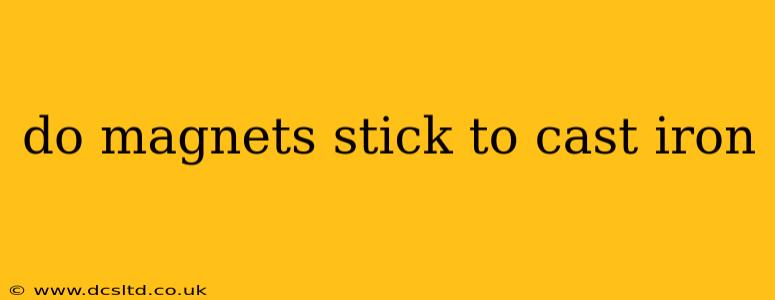Cast iron's magnetic properties are a common point of curiosity, especially for those working with metal or exploring the world of magnetism. The short answer is: yes, magnets generally stick to cast iron. However, the strength of the attraction can vary depending on several factors. This comprehensive guide delves into the reasons why, exploring the nuances of this seemingly simple question.
Why Do Magnets Stick to Cast Iron?
Cast iron's magnetic behavior stems from its composition. It's primarily an alloy of iron, carbon, and silicon. Iron is a ferromagnetic material, meaning it possesses strong magnetic properties and can be easily magnetized. The carbon and silicon content in cast iron can slightly affect its magnetic susceptibility, but the high iron content ensures that it remains significantly magnetic. When a magnet is brought near cast iron, the iron atoms within the cast iron align themselves with the magnetic field of the magnet, creating a magnetic attraction.
What Factors Affect the Strength of the Magnetic Attraction?
While cast iron is generally magnetic, several factors can influence how strongly a magnet adheres to it:
1. The Type of Cast Iron:
Different grades of cast iron have varying compositions, leading to differences in magnetic properties. White cast iron, for example, which has a higher carbon content, might exhibit slightly weaker magnetism than gray cast iron. These variations are usually minor, and magnets will still stick to all types of cast iron.
2. The Strength of the Magnet:
A stronger magnet will naturally exert a greater force on the cast iron, resulting in a stronger attraction. Neodymium magnets, known for their potent magnetic fields, will stick more firmly to cast iron than weaker ceramic magnets.
3. The Surface Condition of the Cast Iron:
Rust, paint, or other coatings on the cast iron surface can impede the magnetic interaction. A clean, bare surface will generally result in the strongest attraction.
4. The Thickness of the Cast Iron:
While not as significant as other factors, thicker pieces of cast iron might exhibit slightly stronger magnetism simply due to the greater volume of iron atoms.
What About Stainless Steel? Does it behave similarly?
This often leads to confusion. While both cast iron and some stainless steels contain iron, the crucial difference lies in the chromium content. Chromium is a key alloying element in stainless steel, and its presence can significantly reduce or even eliminate the material's magnetic properties. Most stainless steels are not magnetic, or at least only weakly so, unlike cast iron.
Can Cast Iron Become Permanently Magnetized?
Yes, cast iron can be magnetized, though usually only temporarily. If exposed to a strong magnetic field, some of the iron atoms will retain a degree of alignment even after the external magnetic field is removed, resulting in a weakly magnetized piece of cast iron. This temporary magnetization is often easily lost through heating or mechanical shock.
Is it Possible for a Magnet NOT to Stick to Cast Iron?
While rare, there are a few scenarios where a magnet might not appear to stick:
- Extremely thick coatings: A very thick layer of paint, rust, or other non-magnetic material could significantly weaken the magnetic attraction to the point of being imperceptible.
- Extremely low-grade cast iron: Although uncommon, cast iron with an unusually low iron content may exhibit weak magnetic properties.
In conclusion, while magnets generally stick to cast iron due to its high iron content, the strength of this attraction depends on several factors. Understanding these nuances allows for a clearer understanding of the interaction between magnets and cast iron.
